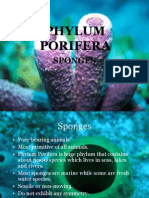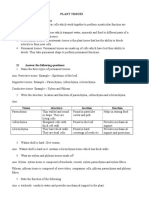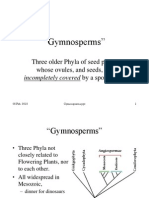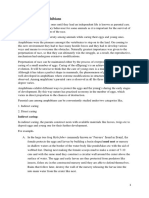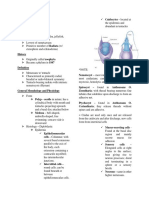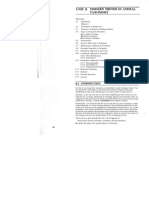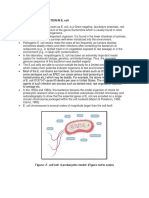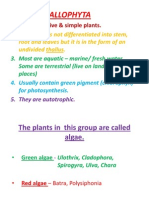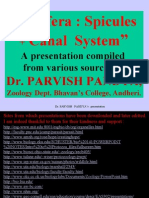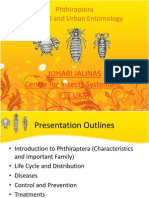0 ratings0% found this document useful (0 votes)
262 viewsPhylum Porifera
Phylum Porifera
Uploaded by
yashsodhani1. The document discusses the phylum Porifera, which includes sponges. It notes that sponges are the simplest multicellular organisms with a cellular organization and lack true tissues.
2. There are approximately 5,000 known species of sponges. They are aquatic, sedentary, asymmetrical organisms that live in water and filter feed using pores and chambers.
3. Sponges have three main classes - Calcarea, Hexactinellida, and Demospongia - which differ in their skeleton composition and structure. Glass sponges like Hyalonema are hexactinellids.
Copyright:
© All Rights Reserved
Available Formats
Download as DOCX, PDF, TXT or read online from Scribd
Phylum Porifera
Phylum Porifera
Uploaded by
yashsodhani0 ratings0% found this document useful (0 votes)
262 views2 pages1. The document discusses the phylum Porifera, which includes sponges. It notes that sponges are the simplest multicellular organisms with a cellular organization and lack true tissues.
2. There are approximately 5,000 known species of sponges. They are aquatic, sedentary, asymmetrical organisms that live in water and filter feed using pores and chambers.
3. Sponges have three main classes - Calcarea, Hexactinellida, and Demospongia - which differ in their skeleton composition and structure. Glass sponges like Hyalonema are hexactinellids.
Original Description:
phylum
Copyright
© © All Rights Reserved
Available Formats
DOCX, PDF, TXT or read online from Scribd
Share this document
Did you find this document useful?
Is this content inappropriate?
1. The document discusses the phylum Porifera, which includes sponges. It notes that sponges are the simplest multicellular organisms with a cellular organization and lack true tissues.
2. There are approximately 5,000 known species of sponges. They are aquatic, sedentary, asymmetrical organisms that live in water and filter feed using pores and chambers.
3. Sponges have three main classes - Calcarea, Hexactinellida, and Demospongia - which differ in their skeleton composition and structure. Glass sponges like Hyalonema are hexactinellids.
Copyright:
© All Rights Reserved
Available Formats
Download as DOCX, PDF, TXT or read online from Scribd
Download as docx, pdf, or txt
0 ratings0% found this document useful (0 votes)
262 views2 pagesPhylum Porifera
Phylum Porifera
Uploaded by
yashsodhani1. The document discusses the phylum Porifera, which includes sponges. It notes that sponges are the simplest multicellular organisms with a cellular organization and lack true tissues.
2. There are approximately 5,000 known species of sponges. They are aquatic, sedentary, asymmetrical organisms that live in water and filter feed using pores and chambers.
3. Sponges have three main classes - Calcarea, Hexactinellida, and Demospongia - which differ in their skeleton composition and structure. Glass sponges like Hyalonema are hexactinellids.
Copyright:
© All Rights Reserved
Available Formats
Download as DOCX, PDF, TXT or read online from Scribd
Download as docx, pdf, or txt
You are on page 1of 2
Hyalonema
1.4 Phylum Porifera.
(i) Introduction : Lowest multicellular animals or metazoans without true tissues, i.e.,
at Cellular level of body organization. Familiar as sponges, these animals are well-known
for their ability to absorb and withhold fluids. The word Porifera means pore bearers (Gr.,
porus = pore; ferre = to bear); Their body wall has numerous minute pores, called ostia,
through which a continuous current of outside water is drawn into the body. About 5,000
species are known.
(ii) Brief History : Robert Grant (1825) finally proved that sponges are animals, and
coined the name Porifera for these. Schulze (1878), Butschli (1884), Sollas (1884) and
Delage (1898) separated sponges from other metazoans on basis of embryological studies,
and suggested a separate group, Parazoa for these.
(iii) Salient features : Phylum porifera has the following salient features :
(1) All the sponges are Aquatic, Sedentary, Asymmetrical or Radially, First
multicellular organisms and have cellular grade of organization.
(2) They are diploblastic. Ectoderm is formed by pinachocyte and endoderm is formed
by choanocyte. Both layers are called pinachoderm and choandoderm.
(3) The body is perforated by numerous minute pores called ostia.
(4) The ostia open into a large cavity called spongocoel.
(5) The spongocoel opens to the outside by a large opening called osculum.
(6) The sponges possess an endoskeleton in the form of calcareous spicules.
(7) Excretion and respiration occur by diffusion.
(8) They have greater power of regeneration.
(9) Reproduction takes place by asexual or sexual methods.
(10) Development is indirect or direct. The common larval are parenchymula,
amphiblastula, etc.
(a) Class 1. Calcarea
(1) Skeleton is formed of Calcareous spicules.
(2) Radially symmetrical.
(3) Choanocyte cells are large and conspicuous
Examples : Clathrina, Leucosolenia, Sycon, etc.,
Euplectela is the sponge which is given as a Gift in Japan.
Leucosolenia is a smallest sponge.
Ectorderm is formed by pinachocyte and endoderm is
formed by choanocyte. Both layer is called pinachoderm and
choanoderm.
(b) Class 2. Hexactinellida
(1) Skeleton is formed of six rayed triaxon, silicious spicules,
(2) Canal system is branched or unbranched.
(3) Radially symmetrical.
(4) These are also known as glass sponges.
Examples : Pheronema, Hyalonema, etc.,
Hylonema is a Glass rope sponge.
(c) Class 3. Demospongia
(1) Skeleton either absent or present. When present it is either formed of spongin fibres
or combination of spongin fibres and silicious spicules.
(2) The silicious spicules when present are never six rayed
(3) The canal system is complicated Rhagon type
(4) These sponges are of great economic importance
Euspongia
Sycon
Examples : Cliona, Spongilla, Chalina, Euspongia, Hippospongia, Oscarella, etc.,
Spongilla is a fresh water sponge.
You might also like
- Phylum PoriferaDocument30 pagesPhylum PoriferaEloisa Lopez100% (2)
- Characteristics of Phylum Porifera (Sponges)Document15 pagesCharacteristics of Phylum Porifera (Sponges)Pralex PrajapatiNo ratings yet
- MarchantiophytaDocument9 pagesMarchantiophytax456456456xNo ratings yet
- Phylum PoriferaDocument17 pagesPhylum PoriferaRhiZhal SquDetto FrizTalNo ratings yet
- Obelia: Habitat, Structure and DiagramDocument24 pagesObelia: Habitat, Structure and DiagramSunil BundelaNo ratings yet
- Describe The Taxonomical of Identification of Cultivable FishesDocument5 pagesDescribe The Taxonomical of Identification of Cultivable FishesNarasimha MurthyNo ratings yet
- Crustaceae Larval Forms PDFDocument12 pagesCrustaceae Larval Forms PDFAfridi ShaikhNo ratings yet
- Comparative Anatomy of Respiratory SystemDocument129 pagesComparative Anatomy of Respiratory Systemgerman guazaNo ratings yet
- Lec4 SocialInsects TheSociety NotesDocument3 pagesLec4 SocialInsects TheSociety NotesAlexandra LvNo ratings yet
- Secondary Growth in Dicot StemDocument22 pagesSecondary Growth in Dicot Stemfastandthecurious2161No ratings yet
- Anatomical Structure of RootDocument5 pagesAnatomical Structure of RootkingNo ratings yet
- Kingdom ProtistaDocument34 pagesKingdom ProtistaVerrell RahardjoNo ratings yet
- Life Cycle of Silk WormDocument13 pagesLife Cycle of Silk WormSuganthi LakshminarayananNo ratings yet
- ObeliaDocument7 pagesObeliaPralex PrajapatiNo ratings yet
- Respiratory System: StructureDocument29 pagesRespiratory System: StructureDr. Abir Ishtiaq100% (1)
- Plant TransportDocument23 pagesPlant TransportBalakrishnan MarappanNo ratings yet
- Occurrence of CharaDocument12 pagesOccurrence of CharaPunam Tamang100% (1)
- Zoology Project of ZrsaDocument4 pagesZoology Project of ZrsaZotei RawihteNo ratings yet
- Accessory Respiratory Organ in FishDocument47 pagesAccessory Respiratory Organ in Fishkoustav kundu0% (1)
- Invert Lab 2Document1 pageInvert Lab 2Beruk BerhaneNo ratings yet
- Plant - Tissue NotesDocument3 pagesPlant - Tissue NotesDikshit Rishi JainNo ratings yet
- Nostoc: - Group 1 Section - A B.Sc. (Hons) - BiotechnologyDocument28 pagesNostoc: - Group 1 Section - A B.Sc. (Hons) - BiotechnologyriddhiNo ratings yet
- Movement and Support in AnimalsDocument32 pagesMovement and Support in Animalsathirah_izzati100% (3)
- GymnospermsDocument11 pagesGymnospermstapas kunduNo ratings yet
- A Larval PR Oject On Ar ThropodaDocument15 pagesA Larval PR Oject On Ar ThropodaShambadip SenNo ratings yet
- Monocystis AgilisDocument16 pagesMonocystis AgilisRavi JaiswalNo ratings yet
- Unit 6 - General Account and Classification of Eubacteria, Archaebacteria and Cyanobacteria by Dr. Kirtika PadaliaDocument48 pagesUnit 6 - General Account and Classification of Eubacteria, Archaebacteria and Cyanobacteria by Dr. Kirtika PadaliaAbhishek Singh ChandelNo ratings yet
- CHLAMYDOMONASDocument25 pagesCHLAMYDOMONASNavyashree R NNo ratings yet
- Amphibia-Parental CareDocument4 pagesAmphibia-Parental CareAakash VNo ratings yet
- MetamorphosisDocument110 pagesMetamorphosisShivaniNo ratings yet
- Gastropods - Nervous SystemDocument9 pagesGastropods - Nervous SystemKim Esperas SitchonNo ratings yet
- Animal Kingdom by Rakshita SinghDocument82 pagesAnimal Kingdom by Rakshita Singhshakuntalagayakwad5No ratings yet
- Chapter 4 - Cell and TissueDocument41 pagesChapter 4 - Cell and TissueHanh Hoang100% (1)
- Cnidaria SummaryDocument12 pagesCnidaria SummaryJose ArroyoNo ratings yet
- Definition of AllelochemicalsDocument7 pagesDefinition of AllelochemicalsrubyNo ratings yet
- Evolution of Sporophytes and Gametophytes in BryophytesDocument7 pagesEvolution of Sporophytes and Gametophytes in BryophytesKhan KhanNo ratings yet
- Parental Care in Birds and MammlesDocument18 pagesParental Care in Birds and MammlesHusnain AliNo ratings yet
- Invertebrate ZoologyDocument4 pagesInvertebrate ZoologyEdelyn Arguelles100% (1)
- Modern Trends in TaxonomyDocument38 pagesModern Trends in TaxonomyDheeraj K VeeranagoudarNo ratings yet
- Insect HeadDocument24 pagesInsect Headhuzaifa.netflixxNo ratings yet
- Chlorophyceae: VolvoxDocument13 pagesChlorophyceae: VolvoxAnilNo ratings yet
- Ex. No. 9. - Observing The Characters of Apterygota - Collembola and Thysanura and Exopterygota - Odonata, Ephemeroptera and PhasmidaDocument28 pagesEx. No. 9. - Observing The Characters of Apterygota - Collembola and Thysanura and Exopterygota - Odonata, Ephemeroptera and Phasmidaakshayaa aswanthNo ratings yet
- Genome Organization in E. ColiDocument7 pagesGenome Organization in E. ColiAman KhanNo ratings yet
- المحاضرة السادسة Chordata المختصرةDocument28 pagesالمحاضرة السادسة Chordata المختصرةAhmed OrabyNo ratings yet
- Life Cycle of GnetumDocument10 pagesLife Cycle of GnetumChandan Patra100% (1)
- Punam Jaiswal PG-I Sem Classification of PteridophytesDocument5 pagesPunam Jaiswal PG-I Sem Classification of PteridophytesJerbie LlorinNo ratings yet
- ThallophytaDocument6 pagesThallophytaCharan Pal SinghNo ratings yet
- Albugo: White Rust of CrucifersDocument34 pagesAlbugo: White Rust of CrucifersMuhammad MushtaqNo ratings yet
- Animal KingdomDocument22 pagesAnimal KingdomdellfrogNo ratings yet
- Lecture 3 - Intro. To MetazoaDocument30 pagesLecture 3 - Intro. To MetazoaGammee Or100% (1)
- 4 Porifera Spicules & Canal SystemDocument34 pages4 Porifera Spicules & Canal Systemapi-3732735100% (2)
- Soil OrganismsDocument4 pagesSoil Organismstibau4No ratings yet
- PoriferaDocument33 pagesPoriferaRushikesh pawar100% (1)
- Phthiraptera - Johari JalinasDocument24 pagesPhthiraptera - Johari JalinasJohari Jalinas100% (1)
- Phylum EchiuraDocument22 pagesPhylum EchiuraEthyl50% (2)
- 09 Vertebrate Digestive SystemDocument74 pages09 Vertebrate Digestive SystemJohn Andre CruzNo ratings yet
- General Characteristic Features of Superclass PiscesDocument2 pagesGeneral Characteristic Features of Superclass PiscesSKNo ratings yet
- ZOOLOGY - Unit1,2,3,4,5,6Document13 pagesZOOLOGY - Unit1,2,3,4,5,6Amitava BhattacharyaNo ratings yet
- Public Notice: CBSE/JEE/201 7-18Document2 pagesPublic Notice: CBSE/JEE/201 7-18yashsodhaniNo ratings yet
- Surface Tension: From Wikipedia, The Free EncyclopediaDocument1 pageSurface Tension: From Wikipedia, The Free EncyclopediayashsodhaniNo ratings yet
- N Identical Balls Lie Equally Spaced in A Semicircle On A Frictionless Horizontal TableDocument1 pageN Identical Balls Lie Equally Spaced in A Semicircle On A Frictionless Horizontal TableyashsodhaniNo ratings yet
- Ideal Rocket EquationDocument1 pageIdeal Rocket EquationyashsodhaniNo ratings yet
- Forms: AccelerationDocument1 pageForms: AccelerationyashsodhaniNo ratings yet
- Fragmentation in Various Organisms: Yeasts Mushrooms Fungi Kingdom HyphaeDocument1 pageFragmentation in Various Organisms: Yeasts Mushrooms Fungi Kingdom HyphaeyashsodhaniNo ratings yet
- Kinetic EnergyDocument1 pageKinetic EnergyyashsodhaniNo ratings yet
- Variable-Mass System: From Wikipedia, The Free EncyclopediaDocument1 pageVariable-Mass System: From Wikipedia, The Free EncyclopediayashsodhaniNo ratings yet
- Derivation: Mass AccretionDocument1 pageDerivation: Mass AccretionyashsodhaniNo ratings yet
- Mass Ablation/ejection: AblatedDocument1 pageMass Ablation/ejection: AblatedyashsodhaniNo ratings yet
- Fragmentation (Reproduction) : From Wikipedia, The Free EncyclopediaDocument1 pageFragmentation (Reproduction) : From Wikipedia, The Free EncyclopediayashsodhaniNo ratings yet
- Newtonian Mechanics: Single ParticleDocument1 pageNewtonian Mechanics: Single ParticleyashsodhaniNo ratings yet
- Mass of A Simple Pendulum: Small-Angle ApproximationDocument2 pagesMass of A Simple Pendulum: Small-Angle ApproximationyashsodhaniNo ratings yet
- Scotch YokeDocument1 pageScotch YokeyashsodhaniNo ratings yet
- Examples: Mass On A SpringDocument1 pageExamples: Mass On A SpringyashsodhaniNo ratings yet
- FluidsDocument8 pagesFluidsyashsodhaniNo ratings yet
- Doppler Effect: From Wikipedia, The Free EncyclopediaDocument2 pagesDoppler Effect: From Wikipedia, The Free EncyclopediayashsodhaniNo ratings yet
- Projection Uniform Circular Motion OriginDocument1 pageProjection Uniform Circular Motion OriginyashsodhaniNo ratings yet
- Young+Modulus+ 1040120Document4 pagesYoung+Modulus+ 1040120monu991No ratings yet
- Simple Harmonic Oscillator Equilibrium Force Elastic Hooke's LawDocument1 pageSimple Harmonic Oscillator Equilibrium Force Elastic Hooke's LawyashsodhaniNo ratings yet
- Dynamics of Simple Harmonic Motion: Ordinary Differential Equation Newton's Second Law Hooke's Law Mass SpringDocument1 pageDynamics of Simple Harmonic Motion: Ordinary Differential Equation Newton's Second Law Hooke's Law Mass SpringyashsodhaniNo ratings yet
- Accelerates MomentumDocument1 pageAccelerates MomentumyashsodhaniNo ratings yet
- Angular Frequency Calculus Velocity Acceleration: IsochronousDocument1 pageAngular Frequency Calculus Velocity Acceleration: IsochronousyashsodhaniNo ratings yet
- Zelfstudie Van Blastula Naar 3 KiemlagenDocument18 pagesZelfstudie Van Blastula Naar 3 KiemlagenCheyenne ProvoostNo ratings yet
- Review Chapter 1, 2, 3 and 4 Grade 3 - Science Term 1: ObjectivesDocument5 pagesReview Chapter 1, 2, 3 and 4 Grade 3 - Science Term 1: ObjectivesAnnie EveNo ratings yet
- Ies' Home Journal Had Reached An Astounding 700,000. An Increase in Book Readership Also Played A Significant Part inDocument8 pagesIes' Home Journal Had Reached An Astounding 700,000. An Increase in Book Readership Also Played A Significant Part inSilvia Juliana RincónNo ratings yet
- 4th Summative Exam Science 6Document3 pages4th Summative Exam Science 6markjoseph regaladoNo ratings yet
- 01 - Animal Kingdom - 20 Feb. 24Document8 pages01 - Animal Kingdom - 20 Feb. 24ojaswitadas1No ratings yet
- EED 5 Unit 4Document17 pagesEED 5 Unit 4Lara Mariz FragataNo ratings yet
- Animal KingdomDocument84 pagesAnimal KingdomHimanshu RaiNo ratings yet
- Biology: Concept of LivingDocument42 pagesBiology: Concept of LivingOluwatomisin Riches OlatoyeNo ratings yet
- Life Sciences Gr.10 Lesson 18 Cambrian ExplosionDocument15 pagesLife Sciences Gr.10 Lesson 18 Cambrian Explosionmagagulac42No ratings yet
- Reading Activity - SaruDocument2 pagesReading Activity - SaruSNasc FabioNo ratings yet
- 5.3.1.1 Animal Motion OrgansDocument10 pages5.3.1.1 Animal Motion Organsnuriel el khaliqiNo ratings yet
- Bio100a Homework 2Document11 pagesBio100a Homework 2lucasaiu9409100% (1)
- Animal Diversity ExerciseDocument24 pagesAnimal Diversity ExerciseALI ASHRAFNo ratings yet
- Classificationof Living Things Biology KingdomsDocument2 pagesClassificationof Living Things Biology KingdomsHenry AndersonNo ratings yet
- G8 Food Chain PuzzleDocument3 pagesG8 Food Chain PuzzleAnonymous RuslwNZZlNo ratings yet
- Science 2nd Summative TestDocument20 pagesScience 2nd Summative Testmary alyssa dayaoNo ratings yet
- Vertebrates & Invertebrates: by Mariella Hany Grade 5 CDocument8 pagesVertebrates & Invertebrates: by Mariella Hany Grade 5 CyoussefNo ratings yet
- Natural Sciences Diagnostic Test 3rdDocument7 pagesNatural Sciences Diagnostic Test 3rdScribdTranslationsNo ratings yet
- CLASSIFYDocument2 pagesCLASSIFYYuli Prapita SariNo ratings yet
- Endangered Species MDocument2 pagesEndangered Species MReeza HaidaNo ratings yet
- (F 1.0) Blue Submarine No6Document32 pages(F 1.0) Blue Submarine No6Jumper AnonNo ratings yet
- 4as LESSON PLAN - TEMPLATEDocument6 pages4as LESSON PLAN - TEMPLATEAljohn LumapasNo ratings yet
- Year 1 Science Learning From Home (Animals, Including Humans) Activity BookletDocument14 pagesYear 1 Science Learning From Home (Animals, Including Humans) Activity BookletMonigue MoniqueNo ratings yet
- Ficha de Trabajo Autónomo para El Estudiante Nivel/Level: A1 Grado/Grade: 2° Sesión/Session 23Document5 pagesFicha de Trabajo Autónomo para El Estudiante Nivel/Level: A1 Grado/Grade: 2° Sesión/Session 23Salvador RojasNo ratings yet
- DLL - Science 6 - Q2 - W9Document10 pagesDLL - Science 6 - Q2 - W9Edd ZapantaNo ratings yet
- Download ebooks file (eBook PDF) Marine Biology: Function, Biodiversity, Ecology 5th Edition all chaptersDocument30 pagesDownload ebooks file (eBook PDF) Marine Biology: Function, Biodiversity, Ecology 5th Edition all chaptersmuharmumpe100% (2)
- Vertebrates and Invertebrates: VertebraeDocument7 pagesVertebrates and Invertebrates: VertebraeFaraiNo ratings yet
- ZoologyDocument146 pagesZoologyGogull GogullNo ratings yet
- M Caps 18 - (RM) ZoologyDocument3 pagesM Caps 18 - (RM) ZoologyAnurag TiwariNo ratings yet
- TOP SCIENCE 3º.teacher S ResourcesDocument189 pagesTOP SCIENCE 3º.teacher S ResourcestuyasuyaNo ratings yet
